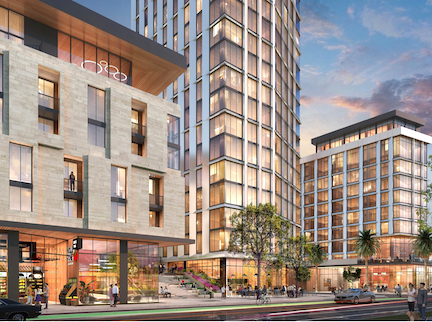
BY BRADEN CARTWRIGHT
Daily Post Staff Writer
State housing officials have approved the city of Palo Alto’s housing plan for the next seven years, closing the door for developers to turn in proposals that don’t follow the city’s rules — like a 17-story tower at Mollie Stone’s grocery store on California Avenue.
Palo Alto was one of three jurisdictions in Santa Clara County that hadn’t had its 2023-2031 Housing Element approved by the state, along with the county itself and the city of Cupertino.
The deadline to get the Housing Element approved was Jan. 31, 2023.
Cities that missed the deadline were subject to the “builder’s remedy” — a provision in state law that allows developers to ignore local zoning restrictions on height and density, as long as 20% of the apartments in their projects are subsidized for low-income residents.
At the Creekside Inn, the Chicago-based Oxford Capital Group wants to build 185 apartments, four townhomes and 200 hotel rooms at 3400 El Camino Real using the builder’s remedy.
Stanford and Acclaim Companies have a builder’s remedy application to replace the McDonald’s and Fish Market at 3150 El Camino Real with a 380-unit apartment complex, reaching 84 feet in height.
Vittoria Management, a Palo Alto-based rental company that goes by “Vrent,” has builder’s remedy applications for 335 apartments at 3606 El Camino Real and 177 apartments at 3781 El Camino Real. Both buildings would be 74 feet tall.
Developer Lund Smith is invoking the builder’s remedy to get 110 apartments approved in a six-story building at the corner of University Avenue and Middlefield Road.
Redco Development LLC applied in November to build three towers at 164 California Ave., with the tallest reaching 177 feet in height.
The project would have 382 apartments, and 77 of them would be for renters who qualify for below-market rates.
City officials haven’t processed the application.
“The city’s position has been that the builder’s remedy does not apply because the city has an adopted Housing Element, which it believes is compliant with the basic requirements of state law,” the city said on its webpage describing the development.
Council approved the city’s Housing Element without getting the state’s sign-off in May 2023. City planners have been going back and forth with state officials ever since to get their support.
Councilman Pat Burt said yesterday that the state finally approved Palo Alto’s Housing Element, and city employees should be working on an announcement soon.
The Housing Element describes where new housing could realistically go and programs to make it easier to build.
Palo Alto has focused on building a new neighborhood along San Antonio Road, next to the Mountain View border and Highway 101.
El Camino Real was added as a focus area, and the city committed to speeding up its reviews of housing applications.
Though the state doesn’t gather data on builder’s remedy projects, the pro-housing legal advocacy group YIMBY Law has identified 93 projects with roughly 17,000 potential units spread across 40 mostly affluent California cities.
Jurisdictions have refused to process nearly half of these applications, arguing that the law doesn’t actually apply, that it’s been misinterpreted or that the law itself is unconstitutional. Eight of the projects are the subject of current lawsuits. Few, if any, builder’s remedy projects have actually resulted in new housing.
Defenders of the current law say that isn’t surprising: Large residential developments take years to complete and the current legal ambiguities in the newly unearthed law are being ironed out by the courts in developers’ favor.
For opponents, the builder’s remedy is the most extreme conclusion of the state’s recent push to build more housing, even if that means taking away local control.

How on earth did they miss this deadline? Were they aware of the consequences?
The plan was submitted on time. The State’s process was slow and chaotic (because so many things changed this time around) and housing activists made it a point (multiple times) to lobby the State to deny approval.
Redwood City met the deadlines and got an approved housing plan. Palo Alto was 19 months late. Why can’t Palo Alto accomplish what Redwood City did?